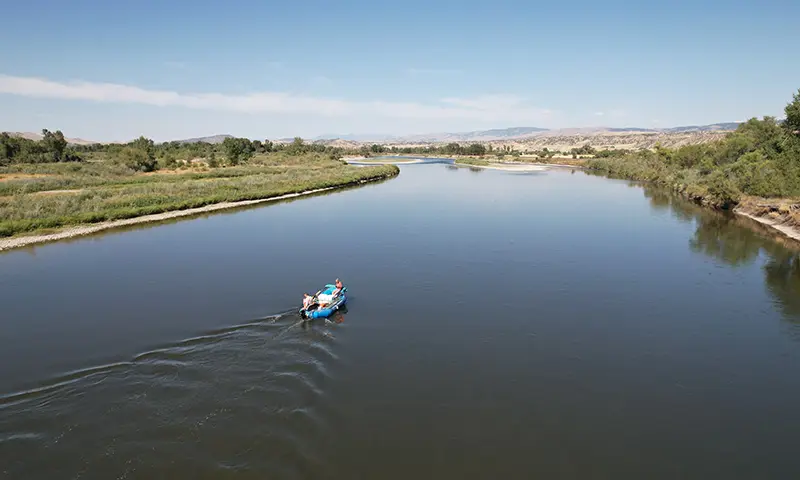The Pulteney Street SurveyWinter '24

Quincey Johnson ’16 and a colleague motor along the Missouri River during a summer pollution patrol.
A River Runs Through it
With drone monitoring, GIS mapping and community outreach, Quincey Johnson ’16 is driving water conservation efforts in Montana that echo her forward-thinking research at HWS.
BY ANDREW WICKENDEN ’09
For Quincey Johnson ’16, the upper basin of the Missouri River is “the best office environment I could imagine.” Emphasis on environment.
Based near the river’s headwaters in Montana, Johnson serves as Outreach Director for Upper Missouri Waterkeeper, an organization dedicated to protecting the basin’s 25,000 square-mile watershed. Her work straddles public relations, advocacy and environmental monitoring; as she leads communications efforts for the organization’s campaigns, litigations and action alerts, she relies on a wide range of tools to raise awareness and encourage the public to “stand up for clean and healthy waterways.”

In 2021, Johnson (right) was licensed as a commercial drone operator and began monitoring large swathes of territory during seasonal pollution patrols. The images and video she captures with drone-mounted cameras are “not only useful for storytelling and advocacy purposes but have also played a role in securing federal Clean Water Act designations for our rivers,” she says.

As a student, Johnson was already searching for environmental solutions using emerging technologies. She and Associate Professor of Environmental Studies Kristen Brubaker (right) used the 3D laser scanning instrumentation LIDAR to examine the carbon storage properties of deciduous forests, resulting in a 2018 publication in the Canadian Journal of Forest Research.
Fieldwork took them from Pennsylvania to New Mexico to Italy, and “in all of those experiences, Quincey was just so tenacious and tough,” Brubaker says. “I think that’s the thing that stands out the most to me — just how brave she was, and how she was willing to say yes.... And how good she was at modeling her work off of others. She didn’t require a lot of coaching because she was also figuring out how to do things on her own.”
During her work with Brubaker, including an Honors project, Johnson says she “developed the technical skills to carry out a research project while also developing a love for working in the field of conservation.... I still utilize Geography Information Systems (GIS) to create maps for communications, a skill I owe fully to Professor Brubaker. I even credit her with encouraging me to move to Montana — I literally wouldn’t be where I am today without her guidance and support.”
Between rapid development, increased pollution, recreational pressure, historically low fish counts, variable snowpack, warming waters and political inertia, the state’s waterways are at a “critical moment... suffering death by a thousand cuts,” Johnson says. Nevertheless, Upper Missouri Waterkeeper’s work “is moving the needle.”
The Gallatin River — a Missouri tributary and “blue-ribbon wild trout fishery” — “has been plagued by excessive nutrient pollution, resulting in neon-green algal blooms each summer that degrade aquatic life and recreational experiences,” she explains.
However, her drone footage of “the miles-long algal blooms” became a key piece of evidence in a petition to the state Department of Environmental Quality. With the petition granted, and a formal EPA ruling, “we are on track to develop a plan to reduce pollution inputs and restore the river to health,” Johnson says.
Safeguarding the natural resources and splendor of the basin “remains an ongoing battle,” she says, “but the victories and progress we’ve made excite and drive me to continue the good fight.”
